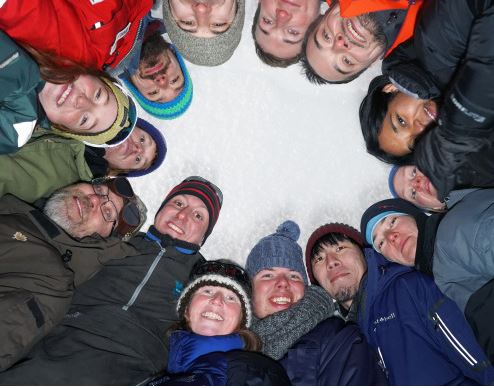Sérgio H. Faria participate in the EastGRIP Field Season 2018


Sérgio H. Faria, Ikerbasque Research Professor and Ramon y Cajal Fellow at BC3, is participating in the EastGRIP 2018 field season from 21 July to 11 August 2018. His main task will be to supervise the ice-core line-scan operations. Line-scanning is a fundamental part of ice-core logging and processing (these are the procedures that follow drilling, with the purpose of uniquely identifying the core pieces in terms of depth, age, and paleoclimate records). An ice-core line-scanner is a device for digitally recording the visual stratigraphy of ice cores continually and in high-resolution (≈0.1 mm/pixel). Details about the device and its methods can be found in the book that I have recently written and published (Faria et al., 2018). Essentially, an ice-core line-scanner consists of a high-resolution digital camera that scans a metre-long ice-core slab lengthwise, recording in the process variations in the optical properties of the ice, and consequently revealing its optical stratigraphy (which is one of several ways of identifying the paleoclimate records of the ice core).
BC3 is the only research institution in the Iberian Peninsula participating directly in this ambitious project. This has been made possible thanks to the close collaboration of BC3 with the Japanese EastGRIP Team, in particular with the Nagaoka University of Technology (NUT) and the National Institute for Polar Research (NIPR), in Tokyo.
EastGRIP
EastGRIP (East Greenland Ice-core Project) is an international project with the primary objective of retrieving a deep ice core by drilling to bedrock through 2550 m of ice of the Northeast Greenland Ice Stream (NEGIS). The Project is financed with national contributions from the participating countries. The budget for the main period (2015–2020) is 70 million DKK and by early 2016 the relative distribution of national funding is as follows: Denmark 56 %, U.S. NSF 13 %, Germany 9 %, Norway 8 %, France 8 %, Japan 8 %, and Switzerland 8 %. Smaller contributions are expected from China, Iceland, Italy, Sweden, and South Korea.
The behaviour of fast-flowing ice streams within the Greenland ice sheet is not well understood. There is an urgent need to understand the flow processes of ice streams, because they are responsible for draining half of the loss of ice mass from the Greenland ice sheet, and many ice streams have doubled their velocities during the last decade. We hope to gain new and fundamental information on ice stream dynamics from this project, thereby improving the understanding of how ice streams will contribute to future sea-level change. The drilled core will also provide a new record of past climatic conditions from the north-eastern part of the Greenland Ice Sheet which will be analysed at numerous laboratories worldwide. As of 15 July 2018, the EastGRIP team has drilled ice down to 1432.82 m depth. Analysis of the ice core is ongoing.
Images of the EastGRIP camp and work are freely available (with clear reference to the source) from:
https://eastgrip.org/gallery/
